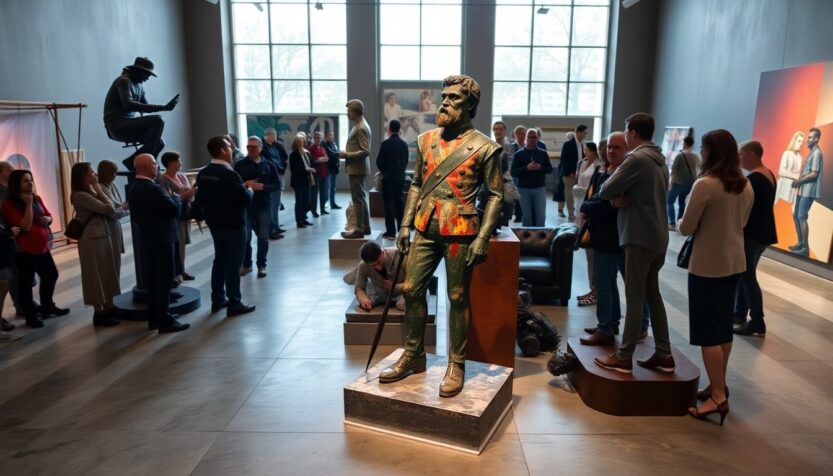In early November, the Geffen Contemporary at MOCA in Los Angeles became the center of conversation with its provocative exhibition titled ‘Monuments.’ This display intertwines decommissioned Confederate statues with the works of modern artists, prompting a dialogue about the legacies these monuments represent. Another venue for the exhibition, The Brick, an arts nonprofit nestled in a diverse part of the city, also featured this thought-provoking collection. During my visit, I encountered an unexpected security protocol—visitors were screened before entering the gallery. This unusual measure hinted at the provocative nature of what lay inside.
At the heart of The Brick, I found Unmanned Drone, a striking sculpture by Kara Walker. This piece repurposes a statue of Thomas J. “Stonewall” Jackson, which had stood for a century in Charlottesville, Virginia, until its removal in. Walker’s reimagining of Jackson and his horse, Little Sorrel, transforms them into a surreal figure that challenges viewers to confront the historical narratives tied to these monuments.
Reimagining history through art
Walker provocatively questions the fate of decommissioned monuments in her exhibition notes. She suggests that the violent history spanning from Reconstruction to the Civil Rights Movement offers artists two choices: either ignore these remnants of oppression or obliterate them entirely. Instead, Walker proposes a third path—to reconstruct and reconfigure these relics into something new. This approach resonates deeply, as it forces audiences to grapple with the past while envisioning a future that acknowledges its complexities.
After experiencing Walker’s haunting sculpture, I proceeded to the Geffen Contemporary, where I met with Hamza Walker, co-curator of ‘Monuments’, and Bennett Simpson, senior curator at MOCA. They stood before a granite block that was once a part of a towering statue of Robert E. Lee. This fragment, now covered in graffiti, serves as a contemporary artwork in its own right, encapsulating the protests and emotions surrounding its removal.
Historical context and the exhibition’s inception
The roots of this exhibition stretch back to significant events in recent history, notably the tragic 2015 shooting at the Emanuel African Methodist Episcopal Church in Charleston, South Carolina. The aftermath saw debates erupt over the presence of Confederate symbols and their implications. Events escalated with the Unite the Right rally in Charlottesville in 2017, which catalyzed a nationwide reevaluation of Confederate statues. In the wake of these events, cities across the United States began dismantling these monuments, with significant legal battles often accompanying their removal.
Interestingly, the exhibition also highlights the current political climate. Just as ‘Monuments’ opened its doors, a statue of Albert Pike, a Confederate general, was reinstalled in Washington, D.C, following its removal during protests against racial injustice in. This swift restoration of Confederate symbols raises important questions about the narratives we choose to uphold and the power dynamics at play.
Artistic interpretations and community reactions
The exhibition features contributions from 19 contemporary artists, each responding uniquely to the theme of monuments and their societal implications. For instance, Walter Price, a veteran artist, created six paintings displayed near a statue of a Confederate naval commander, using art to comment on the complexities of heritage and remembrance.
Another compelling work by Karon Davis depicts her son holding a toy soldier, connecting personal history to the broader narrative of conflict and identity. This piece stands in proximity to other significant statues, creating a dialogue about the intersection of personal and collective histories.
The significance of location
Interestingly, many of the statues included in the exhibition hail from Baltimore, a city known for its progressive political stance yet historically steeped in controversy surrounding Confederate monuments. Hamza Walker, who has deep ties to Baltimore, emphasizes the importance of understanding these statues as products of propaganda rather than mere historical artifacts.
In fact, Baltimore’s mayor expressed the desire not only to remove these statues but to melt them down entirely, posing an existential question: should these monuments be preserved at all? The exhibition exists as a counterpoint to this debate, showcasing how art can serve as a means of recontextualizing history rather than erasing it.
In a striking turn of events, the Lee statue ultimately ended up as part of the exhibition in a different form—melted down and transformed into minimalist sculptures displayed at the Geffen Contemporary. This transformation symbolizes a shift in perspective, suggesting that the act of destruction does not equate to erasure but rather opens avenues for new interpretations and dialogues about the past.
Conclusion
As ‘Monuments’ continues to provoke thought and discussion, it serves as a powerful reminder of the complexities surrounding Confederate statues and their legacies. The exhibition invites audiences to ponder their meanings within contemporary society and challenges us to reconsider how we engage with the remnants of our history.

